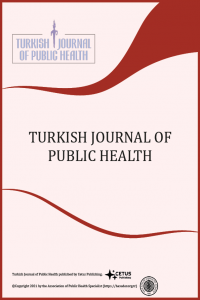Afetlere Karşı Sosyo-Ekonomik Kırılganlık Endeksinin Değerlendirilmesi: Türkiye İlleri Örneği
Afet, Risk, Savunmasızlık, Sosyo-Ekonomik Kırılganlık
Evaluation of Socio-Economic Fragility Index against Disasters: Example Turkey Provinces
Disaster, Risk, Vulnerability, Socio-Economic Fragility,
___
- ADB (Asian Development Bank).Economic and Fiscal Impacts of Disaster in the Pacific. Philippines: Asian Development Bank Publishing; 2008.
- OECD (Organization for Economic Cooperation and Development). States of Fragility 2016: Under Stating Violence.Paris: OECD Publishing; 2016.
- IDMC (Internal Displacement Monitoring Centre). Global Estimates 2014:People Displaced by Disasters. Geneva: Imprimerie Harder; 2014.
- Boer J. Resilience and the Fragile City.International Journal of Security & Development. 2015;4:1-7.
- Tipson FS. Natural Disasters as Threats to Peace. Washington: United States Institute of Peace; 2013.
- Tezer A, Okay N, Kadioğlu M.Standardization of Multi-Hazard Based Risk Mitigation in Spatial Planning.Turkey Geological Congress; 2017 April 10-14; Ankara.
- GAC (Global Agenda Councils). The Role of the Private sector in Fragile State:Catalyzing Investment for Security and Development. World Economic Forum.Switzerland: GAC; 2014.
- TEPAV (Economic Policy Research Foundation of Turkey). Natural disasters.Barriers to Development: World Bank Independent Evaluation Group Report.Ankara: Economic Policy Research Institute; 2005.
- ReliefWeb. Compounding Risk:Disaster. Fragility and Conflict. New York: ReliefWeb Publising;2015. https://reliefweb.int/sites/reliefweb.int/files/resources/ClimateChange_DisastersFragilityConflict_EN_2015.pdf. Accessed: 17.07.2019.
- Dorsch M, Dunz K, Maarek P. Macro shocks and costly political action in non-democracies. Public Choice. 2015;16:381-404.
- Brinkman HJ, Hendrix CS. Insecurity and violent conflict: Causes. consequences and addressing the challenges. WorldFood Programme. Occasional Paper::2011;24:1-28.
- Ian C, Hilhorst D. Human Security and Capacity in Fragile States. Wageningen:Wageningen University; 2009.
- Ünver M, Doğru B. The Determinants of Economic Fragility: Case of the Fragility Five Countries. Akdeniz İ.İ.B.F. Journal.2015;31:1-24.
- Cardona OD. “A System of Indicators for Disaster Risk Management in the Americas” in Measuring Vulnerability to Hazards of Natural Origin: Towards Disaster Resilient Societies. Tokyo:United Nations University Press; 2006.
- Cannon T. Vulnerability Analysis.Livelihoods and Disasters Components and variables of vulnerability:modelling and analysis for disaster risk management. IADB/IDEA Program on Indicators for Disaster Risk Management. Manizales: Universidad Nacional de Colombia; 2003.
- Wisner B. Turning knowledge into timely and appropiate action: Reflections on IADB/IDEA program of disaster risk indicators. Colombia: IADB/IDEA Programa de Indicadores para la Gestión de Riesgos; 2003.
- Benson C, Clay E. Economic and Financial Impacts of Natural Disasters: an Assessment of Their Effects and Options for Mitigation: Synthesis Report. London:Overseas Development Institute; 2003.
- Carreño ML, Cardona OD, Barbat AH. Sistema de indicadores para la evaluación de riesgos. Barcelona: Centro Internacional de Métodos Numéricos en Ingenieria; 2005.
- TÜİK (Turkish Statistical Institute).(2005). Income Distribution and Living Conditions Statistics. http://www. tuik.gov.tr/PreTablo.do?alt_id=1011.Accessed: 12.07.2018.
- TÜİK (Turkish Statistical Institute).(2005). Employment, Unemployment and Wage Statistics. http://www.tuik.gov.tr/UstMenu.do?metod=temelist.Accesses: 23.07.2018.
- TÜİK (Turkish Statistical Institute).(2005). Education Statistics-Statistical Tables and Dynamic Query. http:// tuik.gov.tr/PreTablo.do?alt_id=1018.Accessed: 15.08.2018.
- MEB (T. R. Ministry of Education). (1920).Official Statistics. http://sgb.meb.gov.tr/www/resmiistatistikler/icerik/64. Accessed: 19.08.2018.
- MINISTRY OF HEALTH. (1920). Statistical Yearbooks. https://www.saglik.gov.tr/TR.11588/istatistik-yilliklari.html. Accessed: 25.08.2018.
- UNICEF. Child Powerty in Rich Countries.Floransa: Innocenti Report Card No.6,Innocenti Research Center; 2005.
- Avşar K.Ş. Child Powerty in Turkey. T.R. Prime Ministry Social Assistance and Solidarity General Directorate Social Assistance Expertise Thesis. Ankara:2009.
- TÜİK (Turkish Statistical Institute).(2005). Labor Force Statistics. http://tuik.gov.tr/PreTablo.do?alt_id=1007. Accessed: 30.08.2018.
- İŞKUR. (2003). 2015 Statistics Yearbook(Statistics). https://www.iskur.gov.tr/kurumsal-bilgi/istatistikler/.Accessed:16.008.2018.
- İŞKUR. (2003). 2016 Statistics Yearbook(Statistics). https://www.iskur.gov.tr/kurumsal-bilgi/istatistikler/. Accessed:16.008.2018.
- İŞKUR. (2003). 2017 Statistics Yearbook(Statistics). https://www.iskur.gov.tr/kurumsal-bilgi/istatistikler/. Accessed:16.008.2018.
- TÜİK (Turkish Statistical Institute).(2005). Basic Statistics-Income, Life,Consumption and Poverty. http://tuik. gov.tr/UstMenu.do?metod=temelist.Accessed: 03.09.2018.
- DİE (State Institute of Statistics). (1926).Turkey’s Statistical Yearbook 2004.https://www.ttb.org.tr/kutuphane/ istatistik2006.pdf. Accessed: 04.09.2018.
- Filiztekin A, Çelik M.A. Regional Income Inequality in Turkey. Megaron Journal.2010;5:116-127.
- TÜİK (Turkish Statistical Institute).(2005). Consumer price index(TÜFE). http://tuik.gov.tr/UstMenu.do?metod=temelist. Accessed:05.09.2018.
- T.R. MINISTRY OF TREASURY AND FINANCE. (1923). General Directorate of Accounting and Financial Control- Central Government Budget Statistics by Provinces. https://muhasebat.hmb.gov.tr/iller-itibariyle merkeziyonetim-butce-istatistikleri-2004-2019.Accessed: 12.07.2018.
- OGM (General Directorate of Forest).(1839). E-Library-Statistical. . https:// www.ogm.gov.tr/ekutuphane/Sayfalar/Istatistikler.aspx. Accessed: 09.09.2018.TÜİK (Turkish Statistical Institute).(2005). Crop Production Statistics-Statistical Tables and Dynamic Query.http://tuik.gov.tr/PreTablo.do?alt_ id=1001. Accessed: 10.09.2018.
- Cardona OD, Hurtado JE. Holistic Seismic Risk Estimation of a Metropolitan Center.12th World Conference on EarthquakeEngineering. New Zealand: 2000.
- Kalaycıoğlu S., Rittersberger-Tilic H.,Celik K., Güneş F. Integrated Natural Disaster Risk Assessment: The Socio- Economic Dimension of Earthquake Risk in the Urban Area. Engineering Conferences International, Okinawa: 2006.
- İBB (The Istanbul Metropolitan Municipality). Survey for the Purpose of Collecting Data on Disaster-Oriented Social Vulnerability Analysis: Final Report 2014. Istanbul: İBB Publishing;2014.
- Başlangıç: 2003
- Yayıncı: Halk Sağlığı Uzmanları Derneği
Buzdağının ötesinde: Meslek hastalıklarının psikolojik ve sosyal yönlerine niteliksel bir bakış
EEG çalışmalarında viral enfeksiyon bulaşma riskini azaltma yönergeleri
Servet HASŞERBETÇİ, Eren GÜNSELİ
Sinem SIPÇIK, Ayşe TAT, Osman GÜNAY, Ahmet ÖZTÜRK
Türkiye’de görülen COVID-19 olgu sayılarının tahmininde zaman serisi modelinin kullanılması
Esra KORKMAZ DAHARLI, Sinan YILMAZ
Afetlere Karşı Sosyo-Ekonomik Kırılganlık Endeksinin Değerlendirilmesi: Türkiye İlleri Örneği
Ünal YAPRAK, Turgut ŞAHİNÖZ, Saime ŞAHİNÖZ
COVID-19’a Yönelik Tutum ve Davranışların Planlı Davranış Teorisiyle Araştırılması
Veysel YILMAZ, Erkan ARI, İnci ARIKAN
Didem OKTAR, Cüneyt ÇAM, Sevil AKBULUT ZENCİRCİ, Hatice AYGAR, Gökçe DAĞTEKİN, Seval ÇALIŞKAN PALA, Muhammed Fatih ÖNSÜZ, Selma METİNTAS
Ankara’da iki hastaneye başvuran Suriyeli mültecilere göre algılanan dil engellerinin belirlenmesi
